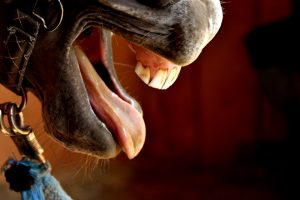Dental Overview
Dental Overview
 Designed to chew rough fibre for over 18 hours a day, a horse’s teeth are very hard wearing. This diet, together with the horse’s chewing action, wears his teeth down at a rate of approximately 2-3 mm per year. To compensate for this wear a horse’s teeth continue to erupt through the gums into the mouth over time until he reaches an age when there is simply noting more left to erupt. When this occurs he simply loses his teeth.
Designed to chew rough fibre for over 18 hours a day, a horse’s teeth are very hard wearing. This diet, together with the horse’s chewing action, wears his teeth down at a rate of approximately 2-3 mm per year. To compensate for this wear a horse’s teeth continue to erupt through the gums into the mouth over time until he reaches an age when there is simply noting more left to erupt. When this occurs he simply loses his teeth.
In the wild the horse’s own chewing action generally wears his teeth evenly to prevent sharp edges and spikes from forming over time. However, as it is now more normal for us to stable our horses and feed them concentrates, their normal chewing activity is reduced which can result in sharp edges forming, causing discomfort and eating problems. Equally, expecting our horses to work in bridles puts other pressures on their mouths, which wouldn’t normally happen in the wild. Good dental care is therefore essential to our horses’ well-being, to prevent disease and to ensure they are comfortable when ridden.
Anatomy of the horse’s mouth
The horse has a total of 36 teeth with males having additional canine teeth, which are not normally present in mares or fillies. Additionally, some horses develop ‘wolf teeth’, which are small functionless teeth that can erupt just in front of the first cheek tooth. The incisor or front teeth are designed for grazing and biting at grass, whilst the cheek teeth or molars, which extend to the level of the eye, are responsible for grinding feed.





